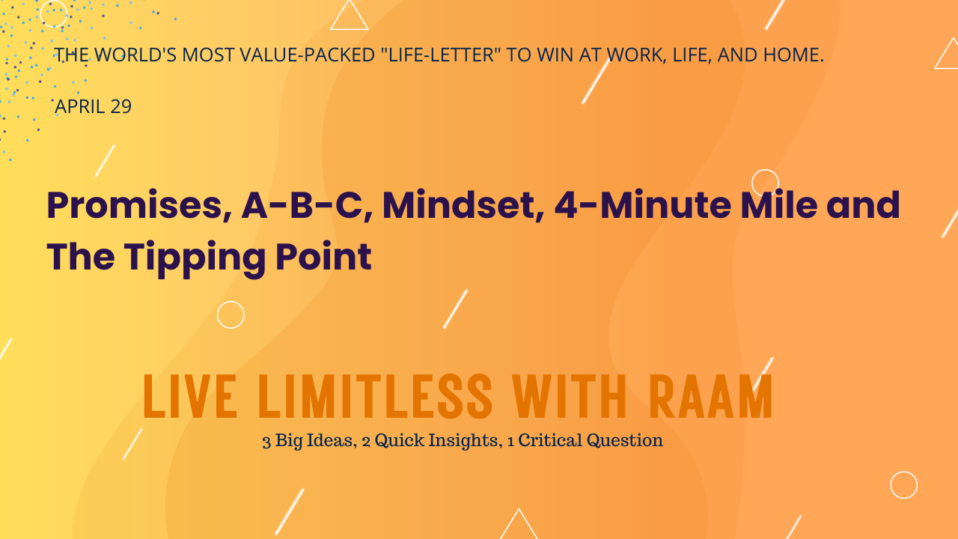Live Limitless with Raam
“The World’s Most Value-packed Newsletter Life-letter to WIN at Work, Life, and Home” with:
3 big ideas, tips or strategies
2 stories, quotes or case-studies
1 critical question to ask yourself
Live Limitless: Promises, A-B-C, Mindset, 4-Minute Mile and The Tipping Point!
read on LIFELETTER.RAAMANAND.COM | APRIL 29, 2023
____________
3 Big Ideas, Tips or Strategies for this week
1. Don’t promise what you can’t deliver.
Avoid commitment debt. Don’t make promises you can’t keep.
Avoid expectation debt. Don’t set expectations you can’t fulfil.
Avoid skill debt. Don’t claim expertise you haven’t developed.
The disciplined achiever can be a trusted provider.
2. Always Be Closing
In the iconic movie “Glengarry Glen Ross” (1992), Alec Baldwin’s character, Blake, delivers a memorable speech to a group of struggling real estate salesmen. One of the key lessons from his speech is the sales tip “Always Be Closing” (ABC).
“Always Be Closing” emphasises the importance of focusing on the end goal of a sale during every interaction with a potential customer. It suggests that salespeople should consistently work towards closing deals by presenting persuasive arguments, addressing concerns, and ensuring the conversation remains on track to achieve the desired outcome.
This sales tip highlights the need for persistence, determination, and a clear focus on the ultimate goal in sales: closing deals and meeting targets.
3. Mindset
In Carol S. Dweck’s book “Mindset: The New Psychology of Success,” she introduces the concept of growth versus fixed mindsets. A fixed mindset believes abilities are static, while a growth mindset believes they can be developed through effort. Embracing a growth mindset leads to increased motivation, resilience, and personal growth.
_____________
2 Stories, Quotes, or Case-Studies for this week
1. The 4-Minute Mile
In the 1950s, a young man named Roger was a talented middle-distance runner, but there was one barrier he couldn’t seem to break: the four-minute mile. At that time, it was widely believed that running a mile in under four minutes was physically impossible for a human. Despite the skepticism, Roger was determined to prove the doubters wrong.
Roger, a medical student at the time, applied his scientific knowledge to his training regimen. He developed a systematic approach, focusing on pacing, nutrition, and innovative training methods. He also enlisted the help of his coach and fellow runners, creating a team to support him in his quest to break the four-minute barrier.
On May 6, 1954, at the Iffley Road Track in Oxford, England, Roger Bannister made history by running a mile in 3 minutes, 59.4 seconds. His incredible achievement proved that the four-minute mile was not an insurmountable barrier, but rather a psychological one.
The most remarkable part of this story is what happened in the months and years following Bannister’s groundbreaking accomplishment. Once the four-minute barrier had been broken, other runners began to achieve the same feat, demonstrating the power of belief and the role of mindset in overcoming perceived limitations.
2. The Tipping Point
In the influential nonfiction book “The Tipping Point” by Malcolm Gladwell, he shares the story of Hush Puppies, a shoe brand that became an iconic example of how trends can seemingly emerge out of nowhere and spread rapidly. Hush Puppies were originally introduced in the late 1950s and became popular in the 1960s. However, by the early 1990s, the brand was struggling, and sales were in decline.
Then, in 1994, something unexpected happened. A few fashionable individuals in New York City’s East Village started wearing Hush Puppies because they were unique and not in the mainstream. As more people caught on to the trend, it began to spread, and Hush Puppies suddenly became wildly popular. In just a short period, the brand went from near extinction to being a must-have fashion item.
Gladwell uses this story to illustrate the concept of the “tipping point,” the moment when a trend, behavior, or idea reaches a critical mass and spreads like wildfire. He identifies three key factors that contribute to the tipping point: the Law of the Few, the Stickiness Factor, and the Power of Context.
The lesson from this story is that seemingly small actions can have a significant impact, and that understanding the factors that contribute to the tipping point can help us create change in our own lives and the world around us. By recognizing the power of influential individuals, the importance of memorable and engaging messages, and the role of context in shaping behavior, we can better understand and leverage the forces that drive social change.

_____________
1 Critical Question to Ask Yourself
Roger Bannister’s story serves as a powerful reminder that we are often our own greatest obstacle. So, it’s time to ask yourself:
“How can I challenge my self-imposed limitations and believe in my ability to succeed so that I can unlock my true potential and achieve greatness?”
Did you like this week’s “Life-letter”? Then, don’t keep this to yourself. Share it with others.
Share this life-letter on Twitter, Facebook, Linkedin, WhatsApp or via email.
Or, copy and paste the link below:
http://lifeletter.raamanand.com
Let’s meet again. Until then, Keep Smiling… Believe in Yourself… and Get all the Best Things in Life,
Raam Anand
Publishing Coach to hundreds of first-time authors around the world
Publisher & Chief Editor at Stardom Books (USA/India)
Author of the International Bestseller, Write Now


Post a comment